(...continued from the previous post)Cogmind Score SheetsI've always called Cogmind's morgue files by yet a different name (of course...): score sheets. When first created the intention was to essential just show a score breakdown and a handful of character stats, but even early on that changed rapidly and score was left as only a very small portion of the file contents...
HistoryShortly after Cogmind's birth for
7DRL2012 I decided to hold a player tournament for fun, but felt that basing it on score alone wouldn't by very exciting, so the first update in preparation for that was to add to the score sheet a variety of other collected stats that described the player's run. Not just the number of kills on enemy type X, but also some less obvious values like "number of tactical retreats," "shots fired from each class of weapon," "number of items of each type lost to attrition," etc.
At the time there were 78 variables, along with a few separate lists of varying types. These served as the basis for a more interesting
tournament while I was still working on improving the game by implementing feature requests.
Then of course as a little side project the game was put on permanent hiatus with no plans to revive it.
Then of course "no plans to revive it" turned into making it something really big, and throughout more than a year of pre-alpha development I kept adding more of those score sheet variables as new features were added (and I came up with more ideas).
Now we have 350 of them.
Score Sheet 0.10After completing the above survey of morgue files in other games, I'm surprised that none of them go as far as to record numerous statistics describing events or highly specific actions that shed light on player behavior, or derive other meaningful stats from the game data. (The DCSS action chart is a notable exception, but still limited in scope.)
Perhaps it's that Cogmind is much more a tactical game than a strategic one. Most roguelikes on the other hand have a strong emphasis on long-term character development and therefore recording and reporting information about the player characters themselves already tells you so much. That's where a majority of the gameplay decisions are reflected, whereas in Cogmind there is almost no emphasis on character development at all; instead it's a game about making minute-to-minute decisions without certainty that your condition or form will be even remotely similar on the next floor, or even around the next corner. As such, the focus of a score sheet should be more about actions, behavioral statistics, and factors external to the character.
To be more specific, here are some of the variables recorded for each run in Cogmind:
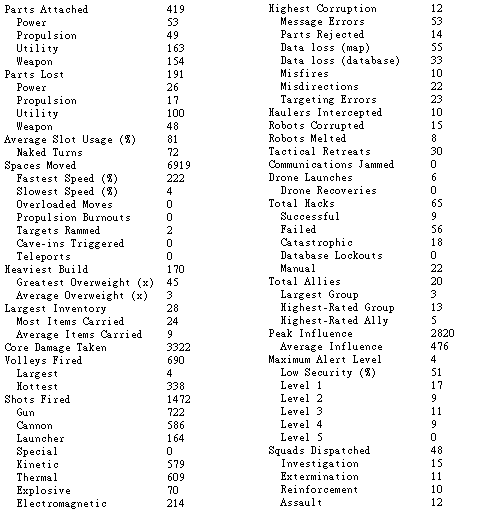 Cogmind score sheet excerpt; data columns doubled up to save space / show more.
Cogmind score sheet excerpt; data columns doubled up to save space / show more.In any case, without additional variables like these Cogmind's score sheet would be pretty barren. Having all the extra data also came in handy when the recent Alpha Challenge 2015 took a page from the 7DRL tournament playbook and added
lots more
achievements based on them. With data like this there are also the many useful graphs that come out of comparing runs or combining data from multiple players as shown in the previous post about
player metrics.
As with the other games, let's look at the header of a Cogmind score sheet then discuss the contents:
(The first thing you'll notice is it doesn't use horizontal space very well. More on that later.)
Cogmind begins with a complete score breakdown, then:
- player stats
- attached parts
- inventory contents
- peak state
- favorite item of each type and subtype
- many gameplay stats (e.g. the earlier variable lists)
- list of identified prototype items
- meta data (play time, UI preferences, etc.)
So-called "peak state" is very important, added because unlike characters in other roguelikes, most Cogminds die naked and alone. Sad, I know. We'd never know what a player's equipment really looked like if only recording it at their point of death (unless they made it to the surface, as in the sheet shown above). So the game also shows what a fallen Cogmind looked like at their best, defined as when the combined combined rating of all their attached parts is at its highest.
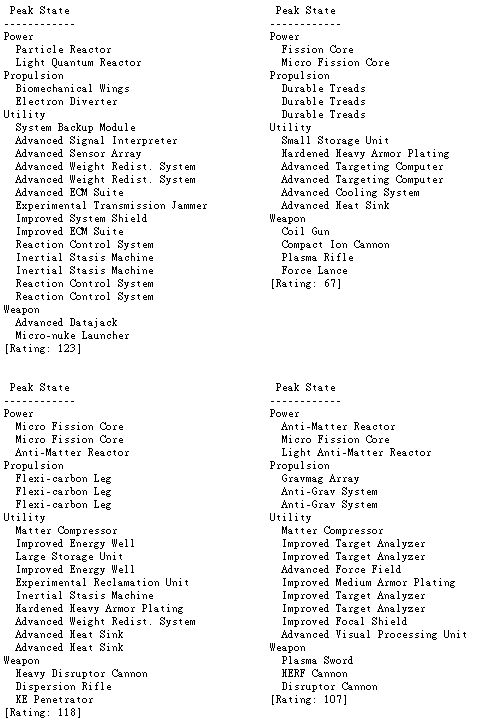 Sample peak states, for fun :D.
Sample peak states, for fun :D.Because Cogmind's gameplay revolves tightly around the items you use, which may change significantly throughout a game (since there is no such thing as skill/class/race limitations that might lock you out of using anything in particular), simply looking at peak state is only informative about a relatively short duration of the run. To tell us more, there are lists of favorite items of each type, further divided into subtypes:
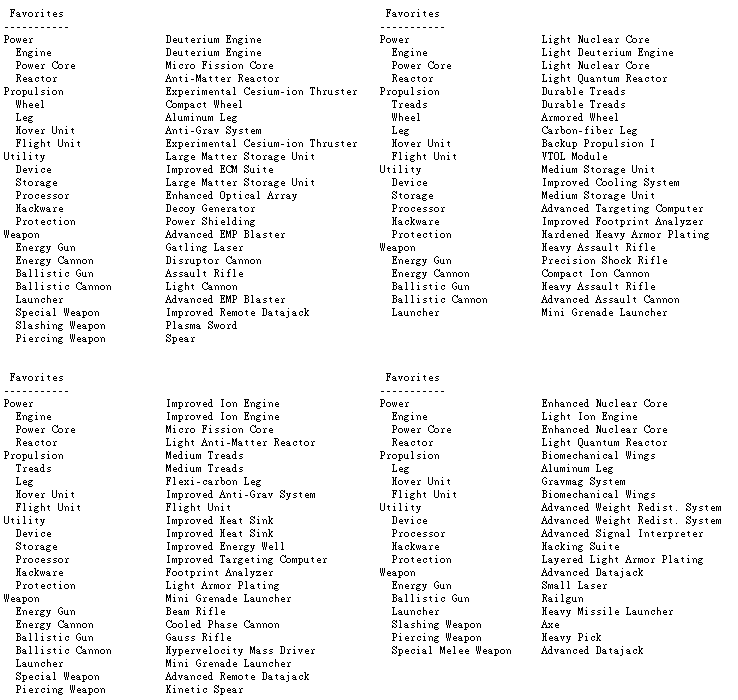 Sample favorite item lists, for double the fun.
Sample favorite item lists, for double the fun.Taking the bottom-left list as an example, while that player may have been a hovering hacker bot at their peak state, according to their favorites they spent most of the game as a treaded heavy weapons platform.
FormatHaving become bloated by simply tacking on more and more variables, while the content is sufficient the score sheet's overall format is far from perfect, with its combination of vertical lists and simple VARIABLE=VALUE format all the way down. All that horizontal white spice should be put to work as we see in the DCSS and Angband morgue files. Many variables could be expanded to show more details, reorganized into meaningful charts, and more...
I'd really like to redesign the entire file to better condense the information, though as mentioned earlier that's a problem for parsing. Using two files, one machine-readable and one human-readable, isn't the greatest solution since players tend to share human-readable files so there would be no way to easily import a file shared that way. However, seeing as the game directly uploads the score sheets now anyway, maybe that would be a route worth considering. Upload a non-human-readable version of the data which is easy to parse, while separately outputting a local text file for the player's own records.
Additional Post-Mortem FeaturesLike many other roguelikes, at the end of a run Cogmind shows a summary window. It contains a complete score breakdown (there aren't all that many score components) as well as select stats, serving as an abbreviated version of the score sheet.
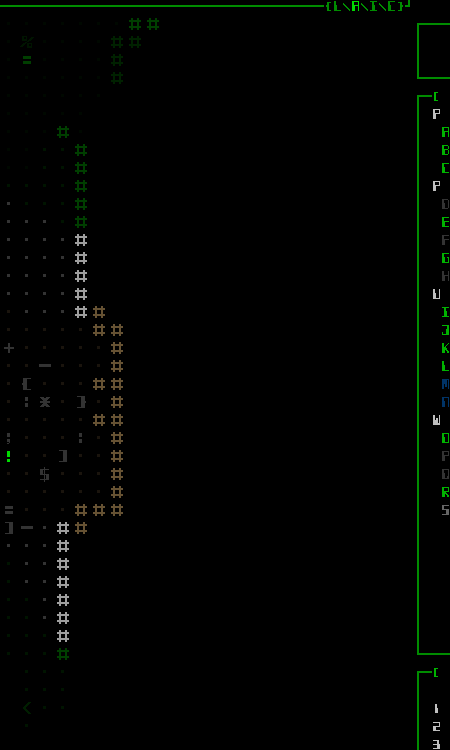 Cogmind gameover screen.
Cogmind gameover screen.Because a full message log is too verbose to include in the score sheet itself and there is no short version yet, that is
not included. Instead, in the options menu the player can choose to not save it (the default) or output it to either a text or html file. The latter has the advantage of being able to use the same colors as the in-game log, making it easier to parse.
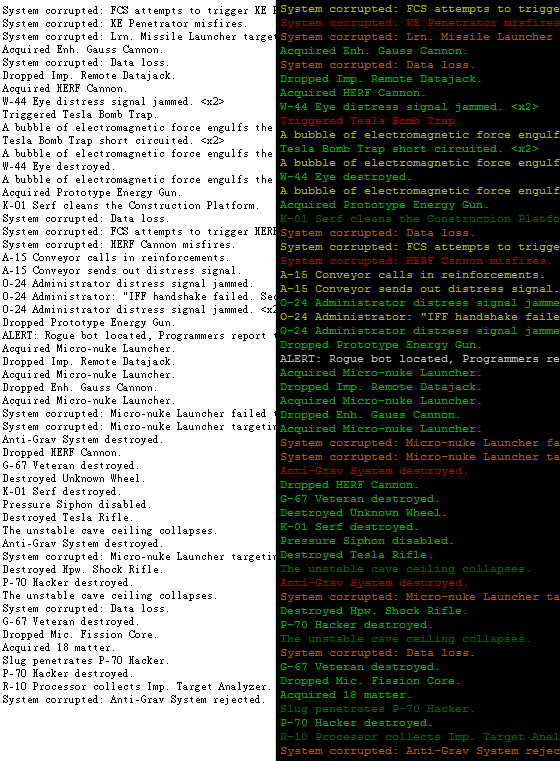 Sample message log output, the same segment in txt (left) and html (right).
Sample message log output, the same segment in txt (left) and html (right).I thought this would be enough, but players have since requested even greater detail in the output logs to better follow progress of the game when re-reading it for learning purposes.
The Possibilities!Outside the existing score sheet and log files, there is the potential for quite a few other related features that serve similar purposes, or present the same information in a different form. Keep in mind that none of what I mention below is 100% certain to happen, but with unlimited time (haha) I'd love to be able to at least test, if not implement, many of these features:
DumpsMid-game character dumps are useful for sharing progress and getting feedback online, so it would be nice to have a dedicated way to do that.
Image sharing is so common on the web now I'm not sure how many players would bother to use a text-based dump option if available. The latter is less readable due to lack of color information, and any time someone pastes/views it without a monospace font it would look terrible, but I put together a mockup anyway:
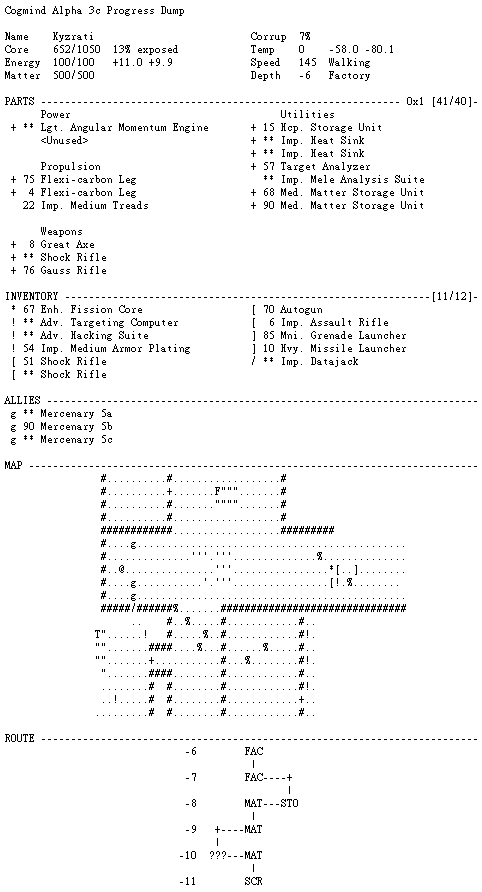 Progress dump mockup (text version).
Progress dump mockup (text version).The current stand-in method for character dumps--a simple screenshot of the HUD--already works pretty well (and is what players have been using) since it shows nearly everything you'd want to know. Its primary drawback is an inability to show more than 12 inventory items at once, an issue for some combat builds. Screenshots are also exceptionally wide for those players using high resolutions since it uses their font settings, making them harder to view on smaller screens.
By rearranging some of the existing windows I put together a mockup of a somewhat more condensed "image-style progress dump," though this one doesn't look so great, and is too wide.
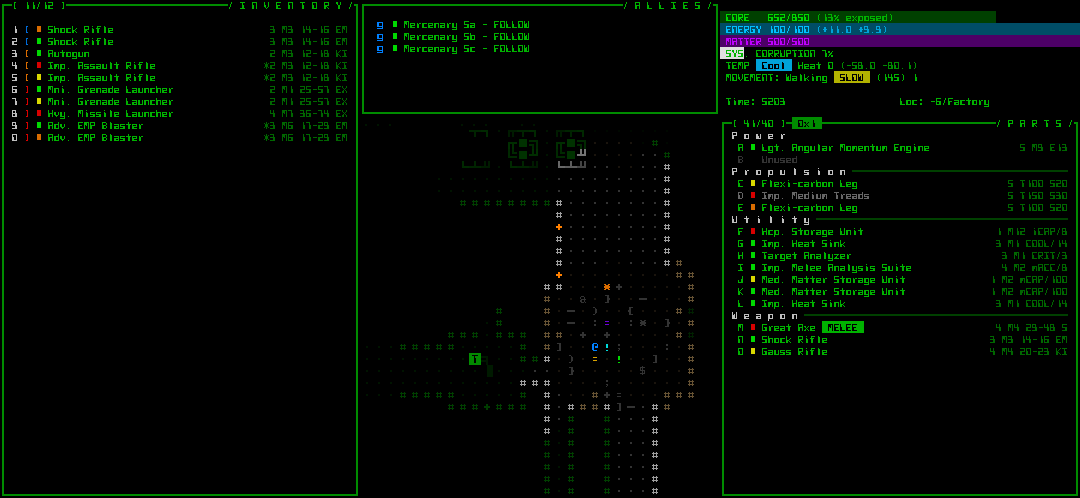 Progress dump mockup (image version, style 1).
Progress dump mockup (image version, style 1).Instead here's an alternative mockup of a truly condensed version without any secondary information--it's nice and tight, and includes space for a lot more inventory items, but no map:
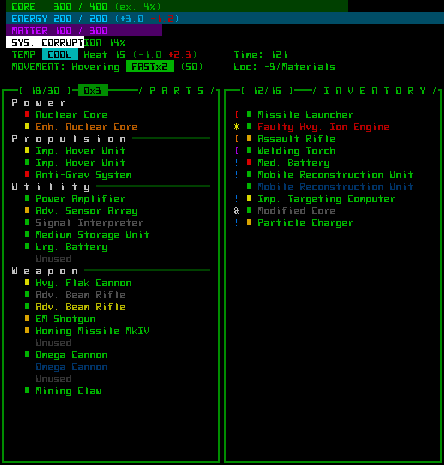 Progress dump mockup (image version, style 2).
Progress dump mockup (image version, style 2).Even cooler would be a way to output your current build--or peak state from a run--using the game's ASCII art to represent the items. Unfortunately at the high end you can have so many parts that the combined art wouldn't fit within any reasonably sized image.
Score Sheet 1.0By the time the score sheet is complete, it should include not only more stats, but also expand to contain a written summary of a run's history, told like a story, as well as a world map showing the route taken through the world.
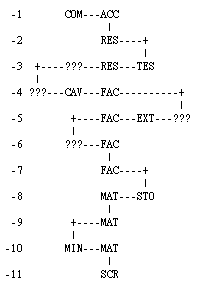 World route mockup (text).
World route mockup (text).Along with the score sheet, there might also be an option to output an accompanying image of the entire last floor explored (not just the part viewable on the screen). This wouldn't uncover unexplored areas (which would too easily reveal secrets), but players could at least learn something about map layouts without having to try to map it themselves (we'll leave that practice in the 80s, or to games with smaller maps). The problem there being that maps can get quite huge, not to mention the data loss to corruption by this point:
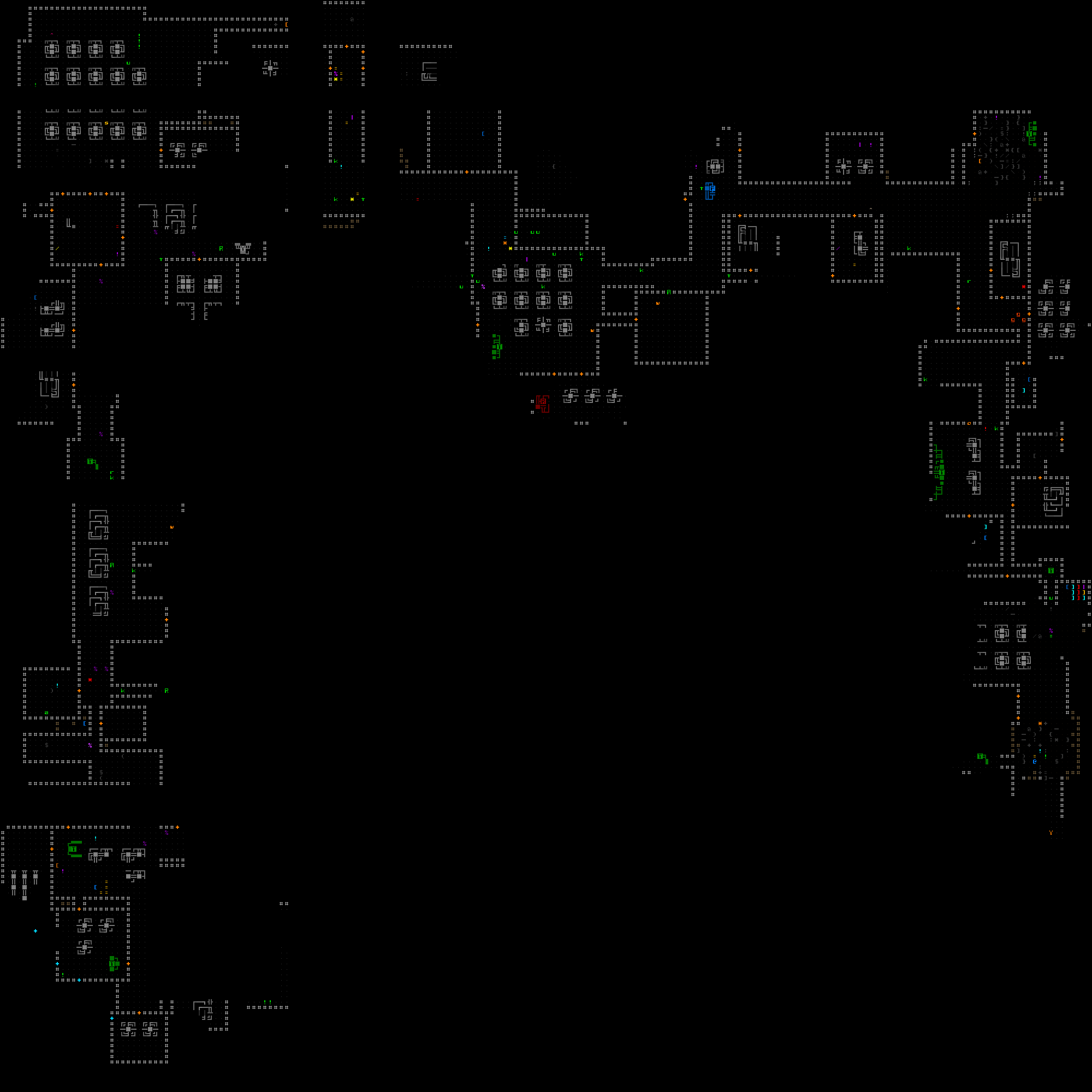 Explored map image (sample). (Click for full size.)
Explored map image (sample). (Click for full size.)It would be a nice addition if the map also highlighted the specific path taken through the map.
Long-Term PerformanceFor those players who can't or don't want to upload score data, we could add a local history of personal high scores. Taking that a step further, we know that roguelike players appreciate more data, so why not track even more performance indicators over time.
Currently the results of each run are stored and viewed in complete isolation, except that each record shows the total number of runs that came before it, and a meta data file stores which items have been discovers and allows their art and usage counts to be viewed in the gallery.
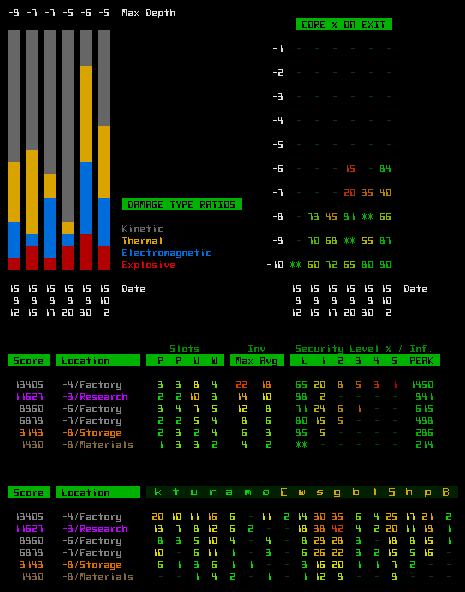 Some examples of performance graphs/charts that could be interesting (mockups).
Some examples of performance graphs/charts that could be interesting (mockups).I can see this being a huge development time sink for too little value if not limited to only a handful of the most useful data.
Another much simpler yet more granular approach to progress, is to have a place where players can review what discoveries they've made in the game so far. We already have this in the form of an "art gallery" that shows all the items collected throughout previous games, including their name, ASCII art, and how many times each was found and used (plus of course a name chosen by the item's associated early supporter as a perk).
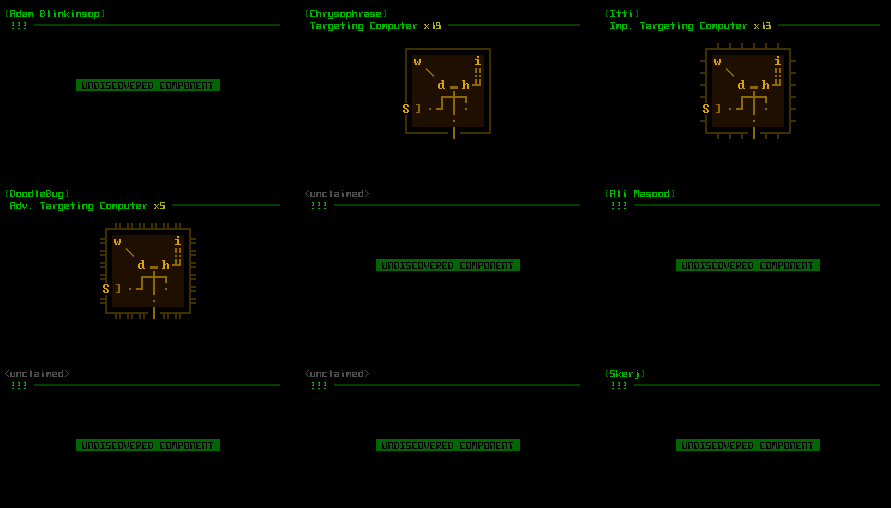 Cogmind's in-game art gallery, with data and discovered/used items from my own runs (click for full size). DON'T OPEN THIS AND LOOK AT THE PLAYER NAMES if you are an alpha supporter and would like to discover your item for yourself!
Cogmind's in-game art gallery, with data and discovered/used items from my own runs (click for full size). DON'T OPEN THIS AND LOOK AT THE PLAYER NAMES if you are an alpha supporter and would like to discover your item for yourself!This feature is a great incentive to keep players exploring, while showing just how much more there is to discover (a lot!). Recording the number of times each item has been used also gives this feature some statistical value for even those players who've discovered most of the items (discovering
all of them is impossible at this point, since many of the best ones can't yet be found).
It would be nice to expand this to include other parts of the game, such as types of maps and robots (however, I don't believe I'd be drawing the latter).
Online DatabaseAs mentioned
before, it would be nice to have an online database with sortable tables and customizable graphs based on the data. Before we get to that point, I may further expand the
current leaderboards by increasing the number of generated html pages to at least include some sortable charts that also link directly to individual records. I'm not rushing into that since I would want to make sure it's somewhat future proof when it comes to new versions.
For the tournament I already wrote a data parser which scrapes a directory for all of its score sheets and compiles everything into a single CSV file. That formed the basis for the stats and analysis I shared
earlier.
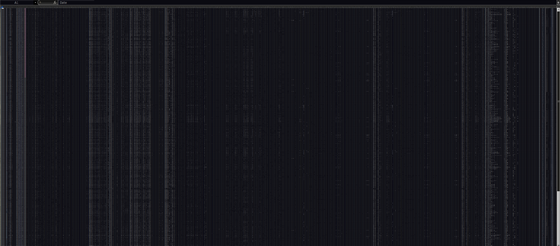 Complete CSV data from the tournament, 234,048 fields in all :D.
Complete CSV data from the tournament, 234,048 fields in all :D.
 Community
Community DevLogs
DevLogs Cogmind (sci-fi robot-themed roguelike) - BETA RELEASED
Cogmind (sci-fi robot-themed roguelike) - BETA RELEASED Community
Community DevLogs
DevLogs Cogmind (sci-fi robot-themed roguelike) - BETA RELEASED
Cogmind (sci-fi robot-themed roguelike) - BETA RELEASED
